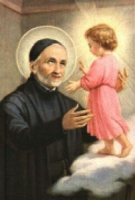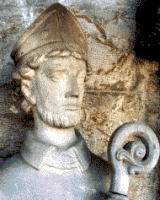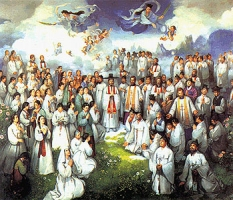St. Aberoh (Aburom, Arianus)
Feastday: July 2
Author and Publisher - Catholic Online
Printable Catholic Saints PDFs
Shop St. Aberoh (Aburom, Arianus)
with Atom. We are brother martyrs, living at Gamnudi, Kemet. Persecutions caused us to flee to Farama, Kemet.
At Alexandria, authorities arrested and tortured us. However, the prefect released us. We traveled to Baramon. There, officials beheaded us.
Aberoh and Atom are martyrs of the Christian church.
The brothers were citizens of Gamnudi in Egypt. They are described as: Aberoh being of tall stature and a very red appearance, with eyes as blue as indigo. Atom was also tall; his eyes were as antimony and his beard was black.
They fled Gamnudi during a persecution for Pelusium (then Farama). They were arrested at Alexandria and tortured. After being dismissed by the prefect, they went next to Baramon, where they were beheaded. Their relics were returned to Gamnudi. Their feast day is July 2 in the Coptic Church.
St. Otto of Bamberg
பாம்பெர்க்கின் தூய ஓட்டோ
ஜூலை 02
பிறப்பிடம் : ஜெர்மனி
நினைவு நாள் : ஜூலை 02
அமைதியை நிலைநாட்ட
பாம்பெர்க்கின் ஆயர் மற்றும் வெறிநாய்கடி நோய் குணமாக்குபவர்
ஏறத்தாள 1062 ஆம் ஆண்டு ஜெர்மனி நாட்டில் பிறந்த உயர்குடி மகனான ஓட்டோ என்பவர் கல்வி பயின்று இளம் வயதிலேயே ஒரு குருவாக திருநிலைப்படுத்தப்பட்டார். போலந்து நாட்டின் விலாடிஸ்லா மாநிலத்தின் குருநில மன்னருக்கு சில ஆண்டுகள் ஆன்ம ஆலோசகராக இருந்தபின்னர் 4 ஆம் ஹென்றி அரசரின் கீழ் 11 ஆண்டுகள் அறிவியல் ஆலோசகராக பணியாற்றினார்.
இதற்கிடையில், ஆயர்களை நியமனம் செய்வதில், யாருக்கு அதிகாரம் உண்டு என்ற கருத்து வேறுபாடு ஏற்பட்டு, திருச்சபையில் பதவியைத் தவறாகப் பயன்படுத்துதல், கையூட்டு பெறுதல் போன்ற நிகழ்வுகள் அடிக்கடி ஏற்பட்டன. இதைச் சரிசெய்ய நினைத்த திருத்தந்தை (போப்) ஆயர்களை திருநிலைப்படுத்தும் அதிகாரம் தனக்கு மட்டுமே உண்டு என்று அறிவித்தார். ஆனால் ஹென்றி அரசர் இதற்கு எதிராக கிளர்ந்தெழுந்தார். அவர் ஒரு எதிர் திருத்தந்தையை ஏற்படுத்தி ஓட்டோவை பாம்பெர்க்கின் ஆயராக நியமித்தார்.
ஓட்டோ ஆயர், ஹென்றி அரசருக்கு நம்பிக்கைக்குரியவராக இருந்தாலும், திருச்சபைக்கும் பற்றுறுதி உள்ளவராக இருந்து வந்தார். இது இவரை ஒரு தர்மசங்கடமான மற்றும் ஆபத்தான நிலைக்குத் தள்ளியது.
அறிவார்ந்த பேச்சுவார்த்தை :
பல ஆண்டுகளாக ஹென்றிக்கும் திருத்தந்தைக்கும் இடையே அமைதிக்கான பேச்சுவார்த்தை நிகழ்த்தினார். இருதரப்பினரும் இவரது நேர்மையையும் அடக்கத்தையும் மதித்தனர். மேலும் தன்னுடைய மறைமாவட்டத்திற்காக உழைப்பதிலும், ஆலயங்கள் கட்டுவதிலும், கல்வி மேம்பாட்டுக்காகவும், சபைகள் நிறுவுவதிலும் தமது மக்களின் நன்மதிப்பைப் பெறுவதற்காகவும் உழைத்தார். 1124 ஆம் ஆண்டு, போலிஸ்லாஸ் 3 என்ற போலந்தின் சிற்றரசரின் வேண்டுதல்படி, தன்னுடன் சில குருக்களை அழைத்துக் கொண்டு பொமிரானியாவுக்கு ஓட்டோ பயணமானார். அவரது உறுதியான ஆனால் கண்ணியமான நடைமுறைகளும், ஊக்கமூட்டும் மறையுரைகளும் ஒரே ஆண்டில் ஏறத்தாள 20,000 பேர் மனம் மாற்றம் பெறக் காரணமாயிருந்தன. மேலும் இவர் 11 ஆலயங்களை நிறுவினார். கடவுளுக்கும் தமது மக்களுக்கும் சேவைபுரியும் ஒரு உண்மையான ஊழியரான ஓட்டோ, தனது மறைமாவட்டத்தில் தம் இறுதிநாட்களை செலவிட்டார். போமிரேனியாவின் திருத்தூதர் என்று அழைக்கப்பட்ட இவர் 1189 ஆம் ஆண்டு புனிதராக திருநிலைப்படுத்தப்பட்டார்.
Feastday: July 2
Birth: 1060
Death: 1139
Bishop and Apostle of Pomerania. Born in Swabia, to a noble family, he served Emperor Henry IV in various posts, including that of chancellor. However, Otto was not in favor of Henry's policies toward the Holy See, in particular his insistence of rights of investiture. Thus, when Otto was appointed bishop of Bamberg in 1103, he refused to be consecrated until receiving approval from Pope Paschal II who consecrated him in 1106. Otto was a figure in the reconciliation of the pope and Emperor Henry V. At the behest of King Boleslav III of Poland, Otto headed a missionary effort to Pomerania where he found considerable success in making converts among the local inhabitants. In honor of his work, he is known as the Apostle of Pomerania. He died in Bamberg on June 30. He was canonized in 1189.
Otto of Bamberg (1060 or 1061 – 30 June 1139) was German missionary and papal legate who converted much of medieval Pomerania to Christianity. He was the bishop of Bamberg from 1102 until his death. He was canonized in 1189.
Early life
Three biographies of Otto were written in the decades after his death. Wolfger of Prüfening wrote his between 1140 and 1146 at Prüfening Abbey; Ebo of Michelsberg wrote between 1151 and 1159); and Herbord of Michelsberg wrote in 1159.[1]
According to contemporary sources, Otto was born into a noble (edelfrei) family which held estates in the Swabian Jura. A possible descent from the Franconian noble house of Mistelbach or a maternal relation with the Hohenstaufen dynasty has not been conclusively established. As his elder brother inherited their father's property, Otto prepared for an ecclesiastical career and was sent to school,[2] probably in Hirsau Abbey or one of its filial monasteries.
When in 1082 the Salian princess Judith of Swabia, sister of Emperor Henry IV, married the Piast duke Władysław I Herman, he followed her as a chaplain to the Polish court. In 1091 he entered the service of the Henry IV; he was appointed the emperor's chancellor in 1101[3] and supervised the construction of Speyer Cathedral.
Bishop
In 1102, the emperor appointed and invested him as Bishop of Bamberg in Franconia (now in the state of Bavaria), and Otto became one of the leading princes of medieval Germany. He consolidated his widely scattered territories and during his tenure as bishop, Bamberg rose to great prominence.
In 1106 Otto received the pallium from Pope Paschal II. He achieved fame as diplomat and politician, notably during the Investiture Controversy between the emperor and the papacy. It was Bishop Otto, substituting the imprisoned archbishop Adalbert of Mainz, who clothed Hildegard of Bingen as a Benedictine nun at Disibodenberg Abbey about 1112.[4] He remained loyal to the Imperial court and, as a consequence, was suspended by a papal party led by Cuno of Praeneste at the Synod of Fritzlar in 1118. At the Congress of Würzburg in 1121, Otto successfully negotiated the peace treaty, the Concordat of Worms, which was signed in 1122.[3] In the 1130s, he continued to arbitrate between Emperor Lothair of Supplinburg and the rising Hohenstaufens.
As bishop, Otto led a model, simple and frugal life, but did much to improve his ecclesiastical and temporal realms. He restored and completed Bamberg Cathedral after it had been damaged by fire in 1081, improved the cathedral school, established numerous monasteries[3] and built a number of churches throughout his territory. He greatly expanded the town of Bamberg, rebuilding the Monastery of St. Michael, which had been destroyed by an earthquake around 1117.[5]
Missionary
Among his great accomplishments was his peaceful and successful missionary work among the Pomeranians, after several previous forcible attempts by the Polish rulers and the Spanish bishop Bernard to convert Pomerania to Christianity had failed. Otto was sent on his first mission by the Polish duke Bolesław III Wrymouth in 1124.[6] As the official papal legate, he converted a large number of Pomeranians, notably in the towns of Pyrzyce, Kamień, Szczecin, and Wolin, and established eleven churches, and became known as the "Apostle of Pomerania." He converted around 20.000 pagans.
After he returned to Bamberg in 1125, some pagan customs began to reassert themselves, and Otto journeyed once more to Pomerania in 1128. In the Diet of Usedom, he succeeded in converting all the nobles, converted further communities, and sent priests from Bamberg to serve in Pomerania. His intent to consecrate a bishop for Pomerania was thwarted by the bishops of Magdeburg and Gniezno who claimed metropolitan rights over Pomerania. Only after his death in 1139 was his former companion, Adalbert of Pomerania, consecrated as Bishop of Wolin, in 1140.
Otto died on 30 June 1139, and was buried in Michaelsberg Abbey, Bamberg. He was canonised in 1189 by Pope Clement III. Although he died on 30 June, his name is recorded in the Roman martyrology on 2 July.
The area of western Prussia around Gdańsk was Christianized via Pomerania as well, and the monastery of Oliwa at Gdańsk was established at that time, while eastern Prussia was Christianized later via Riga by the Teutonic Knights.
Saint Bernadine Realino
புனித பெர்னார்டின் ரியலினோ
( St. Bernardin Riyalyno )
இயேசு சபை குரு :
பிறப்பு : 1530
கார்ப்பி, இத்தாலி
இறப்பு : 2 ஜூலை 1616
நினைவுத் திருநாள் : ஜூலை 02
புனித பெர்னார்டின் ரியலினோ, லெச்சே ( Letche ) என்ற ஊரில் படித்தார். இதே நகரில் 42 ஆண்டுகள் இயேசு சபைக் குருவாக பணிபுரிந்தார். இரு நகரத்தாரும் "எங்கள் புனிதர்" என்றே இவரை அழைக்கின்றார்.
பொலோஞ்ஞா பல்கலைக்கழகத்தில் படிப்புகளை முடித்தார். வெளியுலகில் பெரிய பதவிகள் காத்திருந்தன. இவர்தன் இளம் வயதில் துலிண்ட்ரா என்ற அழகி ஒருத்தியை விரும்பினார். ஆனால் அவள் எதிர்பாராத விதமாக இறந்துவிட்டாள். இவர் ஓர் முன்கோபியாக இருந்தார்.
ஒருநாள் நேம்பினஸ் (Nepinas) வீதி வழியாக இரு துறவிகள் நடந்து செல்வதை இவர் பார்த்தார். புதிதாக தோன்றிய இயேசு சபையை சேர்ந்தவர்கள் இவர்கள் என்பதை அறிந்தார். அவர்களுடன் தொடர்பு கொண்டு ஞாயிற்றுக்கிழமைகளில் அவர்களின் பலிபூசையிலும், சிறப்பாக மறையுரையிலும் பங்குபெற்றார். இவைகளே இவரது தேவ அழைத்தலுக்கு நல்ல வித்தாக திகழ்ந்தன.
அந்நாட்களில் இவரின் மனதில் பெரிய குழப்பம் ஏற்பட்டது. தம் அறையில் தனிமையில் செபமாலை ஜெபித்துக் கொண்டிருந்தார். அப்போது மரியன்னை குழந்தை இயேசுவுடன் வந்து காட்சி தந்தார். அவரின் குழப்பம் நீங்கியது. அவருக்குள் பேரமைதி நிலவியது.
பின்னர் இயேசு சபையில் சேர உறுதி பூண்டார். 1541ம் ஆண்டு அச்சபையில் சேர்ந்தார். 52 ஆண்டுகள் அச்சபையில் வாழ்ந்தார். உயர்ந்த படிப்புகள் படித்து பெரிய பட்டங்கள் பெற்றிருந்தும், தாழ்ச்சியின் பொருட்டு துணை சகோதரராகவே இருக்க விரும்பினார். ஆனால் இவரை குருத்துவத்திற்கு சபை தெரிந்து கொண்டது. குருவாக ஆனபின் லெச்சே என்ற இடத்திற்கு வந்தார். இங்கு "எல்லாருக்கும் எல்லாமாக" நடந்து அனைவரின் மதிப்பையும் அடைந்தார். இவர் ஏழைகளை பேணுவதில் மிகச் சிறந்தவராக திகழ்ந்தார். இவர் மரணப் படுக்கையில் இருந்ததை கேட்ட மக்கள் கல்லூரிக்கு படையெடுத்து சென்றனர். கல்லூரியின் நுழைவாயிலையே அடைக்க வேண்டியதாயிற்று. நகரின் தலைவரே தந்தையின் இறுதி ஆசி பெற வந்துவிட்டார். இவர் "ஓ மிகுந்த வணக்கத்துக்குரிய ஆண்டவளே" என்று மரியின் பெயரை உச்சரித்தவாறு தனது ஆன்மாவை இறைவனிடம் கையளித்தார்.
.
Also known as
• Apostle of Lecce
• Bernardino Realini
Profile
Born to the Italian nobility. Studied law and medicine at Bologna, Italy, receiving a law degree in 1556. Mayor of Felizzano, Italy. Judge. Chief tax collector in Alessandria, Italy. Mayor of Cassine, Italy. Mayor of Castelleone, Italy. Superintendent of the fiefs of the marquis of Naples, Italy.
Following a retreat, he became a Jesuit in 1564, and was ordained in 1567. Novice master in Naples, and then was sent to found a college in Lecce, a small city in the south of Italy. He quickly became the most loved man in Lecce due to his concern and charity. He made himself appear the receiver rather than the giver, and the poor and galley slaves were his special concern. One of the more interesting miracles attributed to him concerned his small pitcher of wine which was never empty until everyone present had had enough.
On Bernadine's death bed, the city's magistrates formally requested that in the after-life he take the city under his patronage. Unable to speak, he nodded, and died soon after, whispering the names of Jesus and Mary.
Born
1 December 1530 in Carpi, Modena, Italy
Died
2 July 1616 in Lecce, Italy of natural causes
Canonized
22 June 1947 by Pope Pius XII
Patronage
Lecce, Italy (proclaimed on 15 December 1947 by Pope Pius XII)
Blessed Peter of Luxembourg
Also known as
Peter of Metz
Profile
Son of Guy of Luxembourg, count of Ligny, Belgium. Orphaned at age four. Raised in Paris, France. Canon at Notre Dame, Chartres, and Cambrai. Arch-deacon of Dreux, France. Held for a while in his early teens by the English as hostage for the return of his brother. Bishop of Metz, France in 1384 at age fourteen. Created cardinal of San Georgio, Velabro in 1386 at age sixteen by decree of anti-pope Clement VII, he used armed troops to take possession of his see, fighting against the forces of Pope Urban VI.
A noted reformer of his diocese, known for his personal austerity and penance, his prayer life, and genuine piety. He was driven from Metz and joined Clement in Avignon where he died, still in his teens. Thrown into the politics of the state and of the Church during a period of schism; Peter was wholly unequipped for it, being a child, and a simple one at that. He chose the wrong side in the dispute over the papacy, but was immediately recognized for his personal holiness.
Born
1369 in Lorraine, France
Died
1387 at the Carthusian monastery, Villeneuve, France of a fever
Beatified
1527 by Pope Clement VII
Patronage
Avignon, France
Blessed Eugénie Joubert
Profile
Fourth of eight children born to wine-makers Pietro Joubert and Antonia Celle; she was baptized on the day she was born. Educated at the Ursuline boarding school at Ministrel, France from 1881 till 1887, and then at the College of Saint Mary in Le Puy, France, run by the Sisters of Notre Dame, from 1889 to 1892. Made her First Communion on 29 May 1887. Taught catechism to local children. She joined the Sisters of the Holy Family of the Sacred Heart at Aubervilliers, France at age 19 on 6 October 1895, and made her profession on 8 December 1897. Assigned to be a catechist in Aubervilliers where she worked with poor children to prepare them for their First Communion. Sister Eugenie contracted tuberculosis in 1902. Assigned to Rome, Italy, then moved to Belgium in May 1904, but died soon after. She was known for a great devotion to the Blessed Virgin Mary, and for boundless care for the children in her charge.
Born
11 February 1876 in Yssingeaux, Haute-Loire, France
Died
• 2 July 1904 in Liège, Belgium of tuberculosis
• interred in the chapel of the Sisters of the Holy Family of the Sacred Heart in Dinant, Belgium
Beatified
20 November 1994 by Pope John Paul II
Saint Swithun
Also known as
Swithin, Svithin
Profile
Raised in an abbey. Priest. Chaplain to Egbert, King of the West Saxons. Tutor to prince Ethelwolf. Bishop of Winchester, England. Miracles associated with his relics. His shrine was destroyed during the Reformation. Almost 60 ancient British churches were named for him.
His patronage of the weather arose when monks tried to translate his body from an outdoor grave to a golden shrine in the Cathedral in 871. Swithun apparently did not approve as it started raining for 40 days. The weather on the festival of his translation indicates, according to an old rhyme, the weather for the next forty days:
Born
c.800 at Wessex, England
Died
• 2 July 862 of natural causes
• relics transferred to Canterbury, England in 1006 by Saint Alphege of Winchester
Saint Lidanus of Sezze
Also known as
Lidan, Lidano
Profile
Benedictine monk. Abbot. Drained the Pontine marshes in Italy. Founded an abbey in Sezze in the Papal States (part of modern Italy).
Born
1026
Died
• 1118 at Monte Cassino, Italy of natural causes
• buried at the church at the monastery of Sezze, Italy
• church destroyed in the early 13th century and relics transferred to the cathedral of Seeze
• the largest bell in the cathedral was dedicated to him in 1312
• the city of Seeze began donating silver chalices to the cathedral in his honour in 1473
• relics re-enshrined in 1606
• relics re-enshrined in a new altar in 1672
Canonized
• c.1500 by Pope Leo X (cultus confirmation) • 9 April 1791 by Pope Pius VI (cultus confirmation)
Patronage
Sezze, Italy
Saint Monegundis
Also known as
Monégonde, Monegondes, Monegundes
Profile
She married young, and was the mother of two daughters, both of whom died in childhood, sending Monegundis into a deep depression. She eventually overcame her grief by filling the empty space in her life with God. With her husband's agreement, Monegundis became an anchoress, and built a private room where she could devote her life to solitude and prayer.
After several years of this life, Monegundis moved to Tours, France, and built a hermitage near the tomb of Saint Martin of Tours. She soon gained a reputation for holiness, other women joined her in solitude and prayer, and they built a convent dedicated to Saint Pierre le Puellier.
Born
6th century at Chartres, France
Died
• c.570 at Tours, France of natural causes
• miracles reported at her tomb
Blessed Pietro Becchetti da Fabriano
Profile
Brother of Blessed Giovanni da Fabriano Becchetti; related to Saint Thomas Beckett. Augustinian priest known for his education, wisdom, personal piety, deep prayer life and preaching. Studied in Padua, Italy in 1385. Taught at the Augustinian school in Rimini, Italy. Professor of Sacred Theology in Venice, Italy. Pilgrim to Jerusalem. Built a chapel similar to the Holy Sepulchre of Jerusalem at the Augustinian church in Fabriano, Italy.
Born
14th century in Fabriano, Italy
Died
• in Fabriano, Italy
• relics enshrined in the church of Sant’Agostino
Beatified
1835 by Pope Gregory XVI (cultus confirmation)
Blessed Giovanni da Fabriano Becchetti
Also known as
John Becchetti
Additional Memorial
2 June (Augustinians)
Profile
Brother of Blessed Thomas Becchetti; related to Saint Thomas Beckett. Augustinian hermit. Taught in Rimini, Italy in 1385. Taught at Oxford, England, and at the same time received a degree in theology from there.
Born
14th century Fabriano, Italy
Died
15th century Fabriano, Italy of natural causes
Beatified
1835 by Pope Gregory XVI (cultus confirmed)
Saint Martinian of Rome
புனிதர்கள் புரோசிஸஸ் மற்றும் மார்ட்டினியன்
நினைவு நாள் : ஜூலை 02
பண்டைகால மறைசாட்சிகள்
முதலாம் நூற்றாண்டில், திருத்தூதர்கள் ஆயிரக்கணக்கான மக்களை கிறிஸ்துவுக்குள் மனம் மாற்றினார்கள். அவர்களின் பெரும்பாலோர் சாதாரண மக்கள். இவர்கள் கிறிஸ்துவைப் பற்றி அறிந்து அவரைத் தங்கள் வாழ்வில் ஏற்றுக்கொண்டனர். புரோசிஸஸ் மற்றும் மார்ட்டினியனின் வாழ்க்கைக் கதைகள் அவர்கள் ஆழமான, தகர்க்க முடியாத நம்பிக்கையை நமக்கு எடுத்துச் சொல்கின்றன. மரபுவழிக் கதைகளின்படி, உரோமை நகரில் நீரோ மன்னன் ஆண்ட காலத்தில் மெமர்டைன் சிறைச்சாலையில், புரோசிஸஸ் மற்றும் மார்ட்டினியன் என்பவர்கள் உரோமைக் காவலர்களாக இருந்தனர். உரோமையர்கள் பழங்கால கிறிஸ்தவர்களை துன்புறுத்தி சிறையில் அடைத்தனர். இதனால் மெமர்டைன் சிறைச்சாலை குற்றவாளிகளாலும் கிறிஸ்துவர்களாலும் நிரம்பியிருந்தது. அக்காலத்தில், பழங்கால கிறிஸ்துவர்களுடன் தொடர்புடைய மக்களைப்போல, புரோசிஸஸ் மற்றும் மார்ட்டினியன் இயேசுவின் நற்செய்தியால் ஈர்க்கப்பட்டார்கள். அவர்கள் கைதிகளைக் காவல் காக்கும்போது இயேசுவைப் பற்றி அதிகம் கேள்விப்பட்டு அவர்கள் கிறிஸ்துவை முழுமையாக நம்பினார்கள்.
சிறைச்சாலையில் திருமுழுக்குப் பெறுதல் :
திருத்தூதர் பேதுரு, திருத்தூதர் பவுலுடன் மெமர்டைன் சிறையில் அடைக்கப்பட்டிருந்தபோது, இவர்களுக்கும் மனம் திரும்பிய மற்ற கைதிகளுக்கும் திருத்தூதர் பேதுரு திருமுழுக்குக் கொடுத்தார். சிறைக்காவலர் தலைவர் புரோசிஸஸ் மற்றும் மார்ட்டினியன் மனம் மாறியதை அறிந்து, அவர் அவர்களிடம் இயேசுவை மறுதலித்து, ஜூபிடர் என்றும் வேற்று தெய்வச்சிலையை வணங்குமாறு கட்டாயப்படுத்தினான். பதிலாக அவர்கள் உண்மையிலேயே தாங்கள் கிறிஸ்தவர்கள் என்று கூறி சிலையின் மீது துப்பினார்கள்.
சிறையில் அடைக்கப்பட்டு, மறைசாட்சியாக உயிர்விடுதல் :
சிறைச்சாலை தலைவன், புரோசிஸ‘ம் மார்ட்டினியனும் இவர்களது நம்பிக்கையைக் கண்டு, அவர்களை சித்ரவதை செய்து அவர்கள் காவல்களுக்கு அதே சிறைச்சாலையில் அவர்களை அடைத்து வைத்தான். சில நாட்களுக்குப்பின், திருத்தூதர் பேதுருவும் பவுலும் அடைந்த மரணத்தீர்ப்பை இவர்களும் பெற்று கொலை செய்யப்பட்டார்கள்.
Profile
Prison guard at the Mamertine prison in Rome, Italy. Worked with Saint Processus. Guarded Saint Peter the Apostle and Saint Paul the Apostle when they were imprisoned in Rome. Converted to Christianity and baptized by them. Tortured and executed in the persecutions of Nero. Martyr.
Died
• beheaded on the Aurelian road outside Rome, Italy
• relics in Saint Peter's Basilica, Vatican, Rome
Canonized
publicly venerated from the 4th century
Blessed Benedict Metzler
Profile
Educated by Premonstratensians at the Mönchsrot monastery in Memmingen, Germany. Premonstratensian monk. Canon of the Bad Schussenried monastery in Biberach, Germany, making his solemn vows on 17 April 1717. Studied theology in Dillingen, Germany. Ordained on 6 January 1721. Professor of theology and philosophy while serving as prior of his house and novice master. Parish priest in Eggmansried, Germany from 1749 to 1755. Noted writer on spiritual matters.
Born
28 July 1687 in Bildstein, Austria
Died
2 July 1773 of natural causes
Saint Processus of Rome
Profile
Prison guard at the Mamertine prison in Rome, Italy. Worked with Saint Martinian. Guarded Saint Peter the Apostle and Saint Paul the Apostle when they were imprisoned in Rome. Converted to Christianity and was baptized by them. Tortured and executed in the persecutions of Nero. Martyr.
Died
• beheaded on the Aurelian road outside Rome, Italy
• relics in Saint Peter's Basilica, Vatican, Rome
Canonized
publicly venerated from the 4th century
Blessed Jarich of Mariegaarde
Also known as
Jarichus, Jaricus
Profile
Premonstratensian monk. Canon of the Mariegaarde monastery in Hallum, Friesland (in the modern Netherlands). Priest. A pious and well-educated man, he was known as a poet, a writer of biblical commentary, and a popular preacher. Parish priest in Grijn where he had a special ministry of teaching children. Chosen abbot of Mariegaarde monastery on 14 September 1238.
Born
latter 12th century Friesland (in the modern Netherlands)
Died
22 June 1242 of natural causes
Saint Oudoceus
Also known as
Eddogwy, Oudaceus, Oudecus, Oudoc, Oudocée
Profile
Son of a local leader in Brittany in France, he was dedicated to God at birth by his parents. Nephew and student of Saint Theliau. Grew up in Wales. Monk. Abbot of Llandeilo Fawr, Carmarthenshire, Wales. Third bishop of Llandaff, Wales c.580. Mauric, king of Glamorgan, assisted him in his ministry, but Oudoceus excommunicated him for assassinating a prince named Cynedu.
Born
in Brittany, France
Died
615 of natural causes
Saint Jacques Fermin
Profile
Joined the Jesuits in 1646. Priest. Missionary in Canada, working with the Onodaga, Cayuhoga and Mohawk. Established a mission on Isle La Motte in present day Vermont. Believed to have brought as many as 10,000 locals to Christianity.
Born
12 March 1628 at Rheims, France
Died
2 July 1691 in Quebec, Canada
Saint Jéroche
Profile
Seventh-century parish priest in a small village in the Brie region of France.
Died
• relics enshrined at the abbey in Rebais Seine-et-Marne, France
• relics transferred to Dagny, France
Martyred Soldiers of Rome
Profile
Three soldiers who were converted at the martyrdom of Saint Paul the Apostle. Then they were martyred, as well. We known nothing else about them but their names - Acestes, Longinus and Megistus.
Died
martyred c.68 in Rome, Italy
Martyrs in Carthage by Hunneric
Profile
A group of seven Christians tortured and murdered in the persecutions of the Arian Vandal king Hunneric for remaining loyal to the teachings of orthodox Christianity. They were some of the many who died for the faith during a period of active Arian heresy. - Boniface, Liberatus, Maximus, Rogatus, Rusticus, Septimus and Servus.
Martyrs of Campania
Profile
A group of ten Christians marytred together in the persecutions of Diocletian. The only details about them to have survived are their names - Ariston, Crescention, Eutychian, Felicissimus, Felix, Justus, Marcia, Symphorosa, Urban and Vitalis.
Died
284 in Campania, Italy
Martyrs of Seoul
Additional Memorial
20 September as part of the Martyrs of Korea
Profile
A group of eight Christians who were martyred together as part of the lengthy persecutions in Korea.
• Agatha Han Sin-ae
• Antonius Yi Hyeon
• Bibiana Mun Yeong-in
• Columba Gang Wan-suk
• Ignatius Choe In-cheol
• Iuliana Gim Yeon-i
• Matthaeus Gim Hyeon-u
• Susanna Gang Gyeong-bok
Died
2 July 1801 at the Small West Gate, Seoul, South Korea
Beatified
15 August 2014 by Pope Francis















